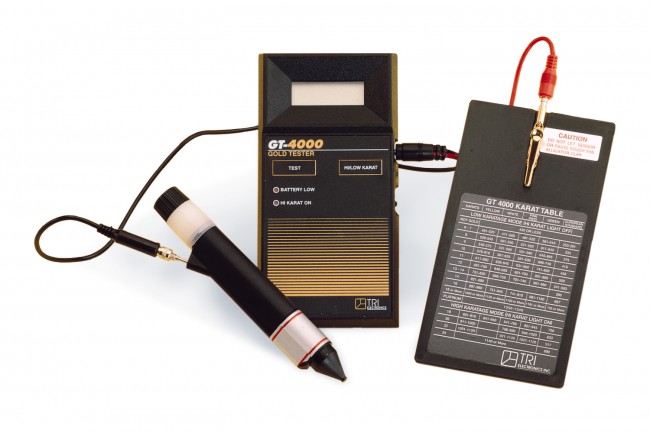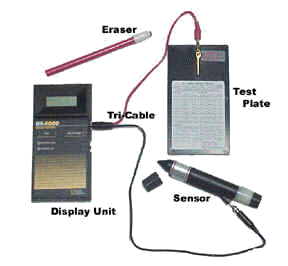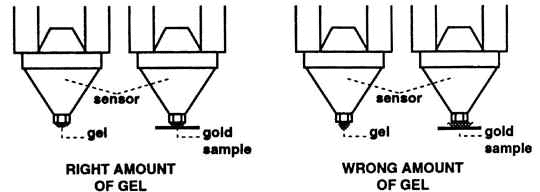GT-4000 Gold Tester Instructions
Introduction
The GT-4000 Gold Testers is a portable electronic device for efficient and quick determination of gold karat value (from 6 to 24 karat), and pure platinum. The GT-4000 Gold Tester also distinguishes solid gold from gold-plated items.
The GT-4000 will develop a residual charge during storage. Upon first use always ignore first test result. Only second test will provide accurate result. As long as unit is activated subsequent first tests will be accurate.
Operation Procedures
The GT-4000 test set consists of a display unit (which operates on two 9-volt alkaline batteries), sensor with rotary cap containing a gel cartridge, a test plate, and a tri-cable for connecting the unit to the sensor and test plate.

Inserting the Testing Gel
- Remove the stationary/rotary cap from sensor nozzle by turning the lower light-colored barrel on the top of the sensor counter clockwise. Do not try to remove by turning the top dark-colored rotary cap, as this will damage the cap assembly.
- Remove the polyethylene cap on the gel cartridge and fully insert the rectangular feed-screw end into the appropriate slot of the rotary cap. Reassemble the cap assembled and cartridge into the sensor body.


- Turn the light-colored barrel clockwise until fully seated.
Turn the dark-colored barrel counter clockwise until the first drop of gel appears at the sensor nozzle.
Setup & Testing
The following step-by-step procedure must be followed to properly perform gold tests

- Connect the black wire to the sensor plug outlet, the black and red wire connector to the display unit, and red wire to the testing plate.
- Turn the unit "ON" by means of the slide switch on the right side of the electronics unit. The unit will automatically be set to low karatage. It is always necessary to test gold in the low karatage mode initially before testing in the high karatage mode. Even if the gold is known to be of high karatage you must pre-test the alloy in the low mode and switch to high mode after testing in the low karatage mode to obtain satisfactory results. After testing in low karat mode, if High Karatage Testing is then desired, press the "HI/LOW KARAT" switch to illuminate the "HI KARAT ON" light and refer to the Hi Karatage Testing section. When the "High Karatage On" light is illuminated, you can only test high karatage (18 karat or greater) gold. You will need to use this mode when measuring 18-24 karat gold. The first test in the high karat mode is a pre-test and may give erroneous resultsAlways test high karatage gold a second time to determine karatage.
3. Select and clean with eraser a testing point on the object; obtain one drop of gel by turning the sensor rotary cap (dark colored barrel) counter-clockwise until gel is dispersed from sensor end. Firmly press the sensor nozzle to the pre-selected and cleaned testing point and press the "TEST" button.
Note: use only a small amount of gel to test. Lightly wipe off excess gel on tissue or towel before test so that only small dome of gel is present on tip of sensor. Excessive use of gel will provide erroneous low karatage readings. It only necessary to apply a small amount of the gel between the gold being tested and the sensor.

After the test, there should be a small round wet spot on the tested gold sample. This verifies a good contact between the sensor tip and the sample.
4. Maintain sensor in the same vertical position for approximately 4-5 seconds while the instrument indicates the numbers on the LCD display. The first test after turning the unit "ON" may give an inaccurate result due to residual charge and should be ignored. Repeat the operation numbers 7 and 8. Then refer to the Karat Table to convert the displayed number into karat value.
Important Notes
- Dispense a drop of the gel and then remove it before each test to eliminate residual charge in sensor.
- Do not allow gel to touch alligator clip during test.
- Some flat herringbone gold chains require a special cleaning technique due to special factory applied coating on the chain. To clean this coating, put a small drop of nitric acid on the test spot and then dry with a paper towel or vigorously clean with eraser. Be sure that the alligator clip and sensor nozzle are making good electrical contact with test object.
- The Gold Tester is able to distinguish between gold-plated and gold-filled items when the plating layer is less than one micron.
- The gel may be stored at room temperature for an extended period (more than one year) ( 26.6 C). For unlimited storage life, the manufacturer recommends storing gel in a standard refrigerator (do not freeze).
- Do not try to open or disassemble the display unit because it will damage the electronic parts and void the manufacturer's warranty.
- Do not use excessive gel for testing.
- If tested gold piece is displayed as "Not Gold", check all connections of wires in unit, plate, and sensor. Check to insure that the proper amount of gel has been dispensed and that it forms a nice little round spot on the item being tested.
- FIRST READING - The machine is not infallible 'end from time to time, for a variety of reasons, you may get a reading, high or low, which is inconsistent with your understanding of the expected karatage. ALWAYS make additional readings in other locations on the jewelry with special attention to cleaning and gel dispersal to verify unusual readings.
- vFINE FINE GOLD - Very fine (thin) chains are very susceptible to crushing by the dispenser. Always avoid pressing the dispenser against the chain when testing fine gold chains while assuring gel contact. Two of three tests are recommended.
- AIR GAP- Occasionally an air bubble will make its way to the tip of the dispenser causing a low or not gold reading. Retest when the result is suspect.
- CLEAN TIP- If the tester has not been used recently, then clean the tip with the plastic cleaner provided by inserting the tip into the nozzle end of the sensor to remove any dried or used gel in the sensor tip. Accumulated dried gel will clog the sensor tip and cause the gel to bypass the plunger in the gel cartridge. If gel drops are not dispensed by rotating the twist cap immediately, clean the sensor using 1171 Electronics SC-10 Cleaner Accessory Kit. To avoid clogging it is good practice to clean the sensor each time the gel cartridge is replaced using the SC-10 Cleaner Kit.
- SOLDER/HEAVY CASTINGS - Solder joints and certain spots on heavy castings may give erroneous readings due to the solder composition or non-homogeneous gold. Retest a new area if your result is suspect.
- ITALIAN GOLD - Many Italian gold chains and necklaces are coated with a wax like material. If the readings are suspect, clean the area to be tested by heavy erasing or with a drop of nitric acid. If the karat value increases with heavy erasure, you may be sure the gold is coated. In all cases, nitric acid will remove the coating.
- SKIN OILS In heavily worn/used pieces, clean the testing item thoroughly with the eraser or non-acetone nail polish remover.
- PLATED GOLD - Often a pin prick or small scratch on suspected plated pieces is sufficient to allow the gel to penetrate to the base material.
Warranteee
The GT-4000 is warranted to be is free from defects in material and workmanship for a period of two (2) years from the date of purchase. This warrantee does not include damage caused by abuse or misuse and in no event shall we be liable for any incidental or consequential damages due to any cause whatsoever. This warranty does not cover any product where an attempt has been made to disassemble the unit.
© 2025 Shor International Corporation & The I. Shor Company. All rights reserved.